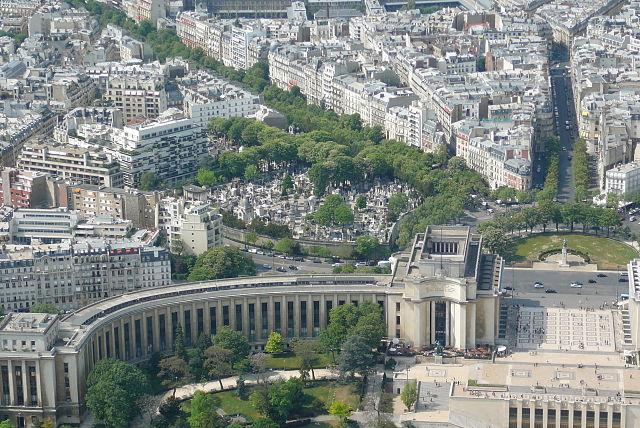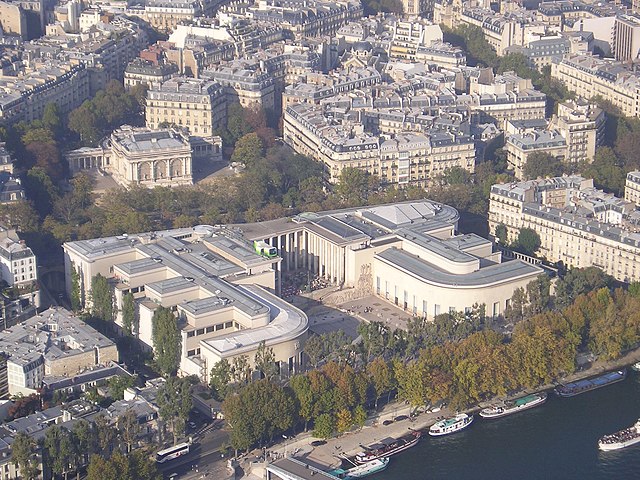Loading AI tools
Municipal arrondissement in Île-de-France, France From Wikipedia, the free encyclopedia
The 16th arrondissement of Paris (le XVIe arrondissement; French pronunciation: [lə sɛzjɛm aʁɔ̃dismɑ̃]) is the westernmost of the 20 arrondissements of Paris, the capital city of France. Located on its Right Bank, it is adjacent to the 17th and 8th arrondissements to the northeast, as well as to the suburb of Boulogne-Billancourt, Hauts-de-Seine to the southwest. Opposite the Seine are the 7th and 15th arrondissements.
16th arrondissement of Paris | |
|---|---|
 The Château de la Muette, the OECD's headquarters in Paris | |
 Location within Paris | |
| Coordinates: 48°51′49″N 2°16′35″E | |
| Country | France |
| Region | Île-de-France |
| Department | Paris |
| Commune | Paris |
| Government | |
| • Mayor (2023–2026) | Jérémy Redler (LR) |
| Area | 7.85 km2 (3.03 sq mi) |
| Population (2021)[1] | 162,061 |
| • Density | 20,645/km2 (53,470/sq mi) |
| INSEE code | 75116 |
Notable sights of the 16th arrondissement include the Arc de Triomphe (at the junction with the 8th and 17th arrondissements) and the Place du Trocadéro, where the Palais de Chaillot stands, itself concentrating three museums and one theatre. Other museums and cultural venues are located in this arrondissement, including the Louis Vuitton Foundation opened in 2014.[2]
With its ornate 19th-century buildings, large avenues, prestigious schools, museums, and various parks, the 16th arrondissement has long been known as one of French high society's favourite places of residence (comparable to London's Kensington and Chelsea or Berlin's Charlottenburg)[3] to such an extent that the phrase le 16e has been associated with great wealth in French popular culture. Indeed, the 16th arrondissement of Paris is France's third-richest district for average household income, behind only its 7th arrondissement and the suburb of Neuilly-sur-Seine, both of which are adjacent.[4]
The 16th arrondissement hosts several large sporting venues, including: the Parc des Princes, which is the stadium where Paris Saint-Germain football club plays its home matches; Roland Garros Stadium, where the French Open tennis championships are held; and Stade Jean-Bouin, home to the Stade Français rugby union club. The Bois de Boulogne, the second-largest public park in Paris (behind only the Bois de Vincennes), is also located in this arrondissement.
The 16th arrondissement was created by the Law of 16 June 1859 which incorporated the villages (now neighborhoods) of Auteuil, Passy and Chaillot into Paris; these villages had become communes after the French Revolution and had been in the Seine department ever since. When the law of 1859 was drafted, it was planned that these villages would form a new arrondissement that would be numbered the 13th arrondissement, but "The rich and powerful moving in did not like the number. They pulled strings and became the 16th, the unlucky association and postmark being transferred to the blameless but less influential folks around Porte d'Italie."[5]
The land area of this arrondissement is 16.305 km2 (6.295 sq mi or 4,029 acres), slightly more than half of which consists of the Bois de Boulogne park. Excluding the Bois de Boulogne, its land area is 7.846 km2 (3.029 sq mi or 1,939 acres). It is the largest arrondissement in Paris in terms of land area.



The population of the 16th arrondissement peaked in 1962, when it had 227,418 inhabitants. At the last census (2009), the population was 169,372. The 16th arrondissement contains a great deal of business activity; in 1999 it hosted 106,971 jobs.
The 16th arrondissement is commonly thought to be one of the richest parts of Paris (as the saying Auteuil-Neuilly-Passy popularised); it features some of the most expensive real estate in France including the famous Auteuil "villas";[note 1] heirs to 19th century high-society country houses, they are exclusive gated communities with huge houses surrounded by gardens, which is extremely rare in Paris. It is also the only arrondissement in Paris to be divided into two separate postal codes. The southern part of the arrondissement carries a postal code of 75016, while the northern part has the code of 75116.
Politics
The 16th arrondissement is one of the strongest areas in the country for the French political right. At the 2017 French presidential election, it gave over 58% of its votes in the first round to right-wing candidate François Fillon, compared to his national result of 20%. It then went on to vote for Emmanuel Macron by a landslide in the runoff.
| Election | Winning candidate | Party | % | |
|---|---|---|---|---|
| 2022 | Emmanuel Macron | EM | 81,90 | |
| 2017 | Emmanuel Macron | EM | 87.37 | |
| 2012 | Nicolas Sarkozy | UMP | 78.01 | |
| 2007 | Nicolas Sarkozy | UMP | 80.81 | |
| 2002 | Jacques Chirac | RPR | 87.99 | |
| 1981 | Valéry Giscard d'Estaing | UDF | 76.58 | |
| Year (of French censuses) |
Population | Density[note 2] (inh. per km2) |
|---|---|---|
| 1872 | 43,332 | 5,523 |
| 1954 | 214,042 | 27,280 |
| 1962 (peak of population) | 227,418 | 28,985 |
| 1968 | 214,120 | 27,290 |
| 1975 | 193,590 | 24,674 |
| 1982 | 179,446 | 22,871 |
| 1990 | 169,863 | 21,650 |
| 1999 | 161,773 | 20,619 |
| 2009 | 169,372 | 21,347 |
| Born in metropolitan France | Born outside metropolitan France | |||
|---|---|---|---|---|
| 74.5% | 25.5% | |||
| Born in overseas France |
Born in foreign countries with French citizenship at birth1 | EU-15 immigrants2 | Non-EU-15 immigrants | |
| 0.6% | 5.7% | 6.7% | 12.5% | |
| 1 This group is made up largely of former French settlers, such as pieds-noirs in Northwest Africa, followed by former colonial citizens who had French citizenship at birth (such as was often the case for the native elite in French colonies), as well as to a lesser extent foreign-born children of French expatriates. A foreign country is understood as a country not part of France in 1999, so a person born for example in 1950 in Algeria, when Algeria was an integral part of France, is nonetheless listed as a person born in a foreign country in French statistics. 2 An immigrant is a person born in a foreign country not having French citizenship at birth. An immigrant may have acquired French citizenship since moving to France, but is still considered an immigrant in French statistics. On the other hand, persons born in France with foreign citizenship (the children of immigrants) are not listed as immigrants. | ||||
Notable companies that have their head offices in the arrondissement include Lacoste, PSA Peugeot Citroën and Lagardère.[6][7]
At one time Aérospatiale, Technip, Veolia and Lafarge also had their head offices in the arrondissement.[8][9][10][11]
In one of the opening scenes of the 1965 James Bond film Thunderball, character Emilio Largo is seen arriving at the headquarters of The International Brotherhood for the Assistance of Stateless Persons. This scene was shot on Avenue d'Eylau in the 16th arrondissement.[12]
The 1972 film Last Tango in Paris was filmed at various locations in the 16th arrondissement, with the apartment the characters stayed in being located in Passy.[13]
A scene of the 2018 action film Mission: Impossible – Fallout was filmed under the elevated Métro station Passy in the arrondissement.[14] Other scenes of the film included ones shot at the Grand Palais (8th arrondissement) and under the Cité de la mode et du design on the Seine (13th arrondissement).
This section needs expansion. You can help by adding to it. (May 2014) |

Here is a list of domestic French sixth-form colleges/high schools in the arrondissement
International schools:
situated near to the 16th arrondissement is the place diana, the pont de l'alma tunnel is known for being the location of the fatal car accident that killed Diana, princess of Wales.
The Paris Dauphine University is in the arrondissement, as well as Paris Institute of Technology, part of Paris Descartes University, one of Paris biggest public universities.
The renowned "classes préparatoires" establishment Intégrale : Institut d'enseignement supérieur privé have one of their campuses in the arrondissement.[21]
The École de langue japonaise de Paris (パリ日本語補習校 Pari Nihongo Hoshūkō), a supplementary Japanese education programme, is held at the École Maternelle et Primaire Saint Francois d'Eylau in the 16th arrondissement.[22][23][24] The school has its offices at the Association Amicale des Ressortissants Japonais en France (AARJF) in the 8th arrondissement.[25]


Seamless Wikipedia browsing. On steroids.
Every time you click a link to Wikipedia, Wiktionary or Wikiquote in your browser's search results, it will show the modern Wikiwand interface.
Wikiwand extension is a five stars, simple, with minimum permission required to keep your browsing private, safe and transparent.